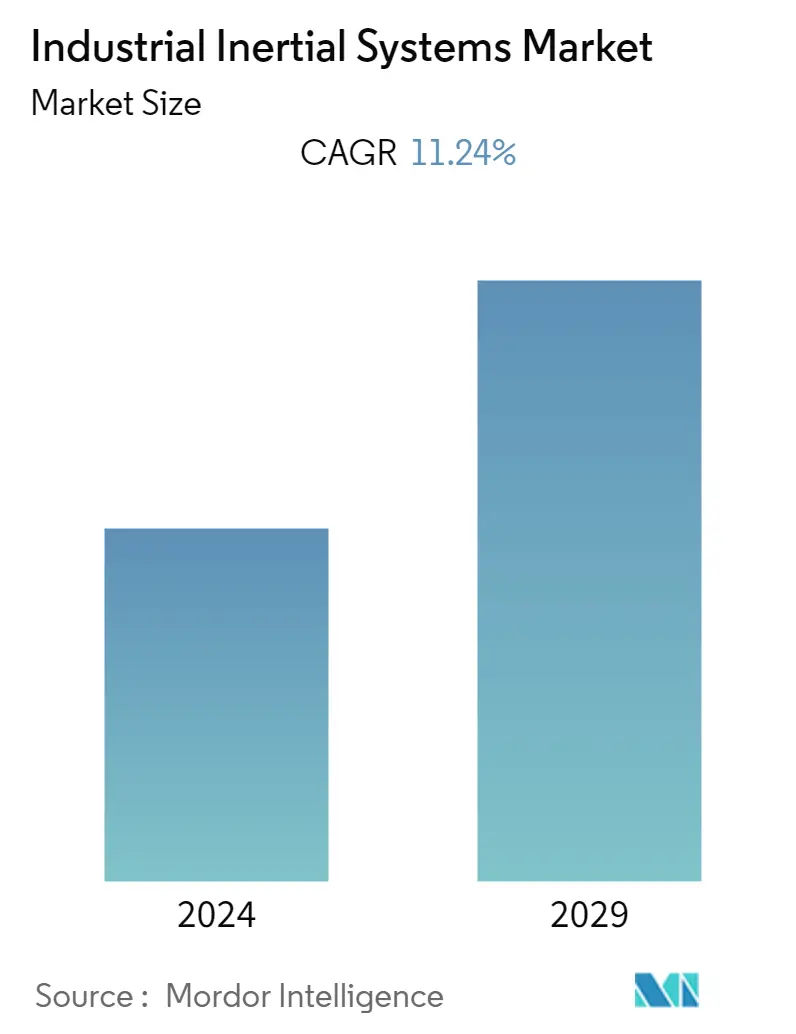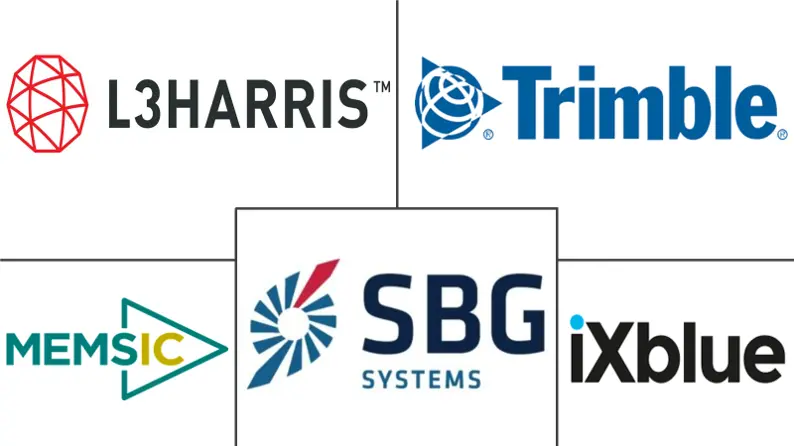Market Size of Industrial Inertial Systems Industry

| Study Period | 2019 - 2029 |
| Base Year For Estimation | 2023 |
| CAGR | 11.24 % |
| Fastest Growing Market | Asia Pacific |
| Largest Market | North America |
| Market Concentration | Medium |
Major Players
*Disclaimer: Major Players sorted in no particular order |
Industrial Inertial Systems Market Analysis
The industrial inertial systems market is expected to grow at a CAGR of 11.24% over the forecast period (2021-2026). The powerful combination of IMUs with other onboard sensor data produces reliability and automation breakthroughs for applications in various industries. The emergence of microelectromechanical systems (MEMS) technology resulted in the miniaturization of mechanical and electro-mechanical elements in sensors and semiconductors, with micro-fabrication and micro-machining techniques. Hence, MEMS have now become an essential part of the future navigation systems, and thus, are influencing the growth of the high-end inertial systems market.
- Moreover, these inertial systems are increasingly being used in deep-water drilling units for advanced operations. Sonardyne International came up with a new DP-INS (inertial navigation system) that combined the complementary characteristics of its long and ultra-short baseline (LUSBL) positioning technology, with high-integrity inertial measurements from its Lodestar AHRS/INS platform. Further, Gyroscope is a kind of inertial sensor used to detect the altitude angle and angular rate. Characteristics, such as small size, less power consumption, lightweight, low cost, and the possibility of batch fabrication, drive their adoption over the conventional gyroscopes. Recent developments have enabled the growth of IMU-enabled GPS devices. An IMU enables a GPS receiver to operate even when GPS-signals are unavailable, such as in tunnels, inside buildings, or when electronic interference is present.
- Furthermore, with the 3D MEMS technology, the companies are offering accelerators assembled in a dual-in-line or dual-in-flat-line plastic package with pins for surface mount and re-flow soldering. With silicone gel, they are environmentally protected, resulting in enhanced performance and reliability in a humid environment and at temperature cycling. Further, inertial sensors find applications in autonomous vehicle navigation, mobile robotics, unmanned land, and ocean systems, and civil and military aerospace. With the introduction of inertial measurement unit (IMU), MEMS inertial sensors can be intelligently programmed and have microcontrollers, miniature batteries, or tiny radio chips that may allow them to send their measurement data online. In March 2019, US-based Micro-Inertial LLC developed IMU and motion sensing systems, offering improved cost, power, reliability, and operating performance characteristics.
- Moreover, the increased defense expenditures in regions, like North America and Europe, have increased the demand for precise operations and equipment. Manufacturers are aiming to cater to this high demand by focusing their R&D on product innovation. For instance, in March 2019, Safran Electronics & Defense released that the company delivered more than 16,400 sensors to customers in 2018. Furthermore, Safran Electronics & Defense has broken its production record for its Quapason Gyroscope. Additionally, in June 2019, EMCORE launched EN-2000 to the Emcore-Orion series of micro-inertial navigation (MINAV) systems. It represents the highest performance in Emcore navigation systems. It attempts to achieve the company's vision of a solid-state and closed-loop design that will deliver higher performance at lower cost than a traditional RLG (ring laser gyroscope) navigational system.
- Further, due to the COVID-19 pandemic country having stopped all major production activities, including its semiconductor industry, which is mostly China, this is expected to significantly influence the global industrial inertial systems market supply chain in 2020, and the market is expected to pick afterward. Disruption in China may have a significant impact on companies across the world and up and down the electronics value chain, directly impacting the sensor market. In 2019, China accounted for over 50% of worldwide semiconductor consumption. Apart from China, the spread of COVID-19 in the Asian continent is expected to restrain the growth rate of the major semiconductor manufacturing countries, such as South Korea. With the slowdown in the global economy, the demand for industrial OEM and automobiles is expected to be influenced until the first half of 2021.
Industrial Inertial Systems Industry Segmentation
The inertial system is an electronic system that continuously monitors the position, velocity, and acceleration of a vehicle, object, submarine, missile, or an airplane and provides navigational data or control without the need for communicating with a base station. Industrial inertial systems, along with the advancement in technology, are helping the organizations in getting data and making decisions on the conclusions or findings it gets. The market study comprises gyroscopes, accelerometers, inertial measurement units, and others, providing solutions to applications, such as aerospace, land, marine, and subsea.
| By Equipment | |
| Gyroscopes | |
| Accelerometers | |
| Inertial Measurement Units | |
| GPS/INS | |
| Multi-Axis Sensors |
| By Application | |
| Aerospace | |
| Land | |
| Marine | |
| Subsea |
| By End-user Industry | |
| Industrial OEM | |
| Defense | |
| Energy & Infrastructure | |
| Transportation | |
| Civil Aviation |
| Geography | |
| North America | |
| Europe | |
| Asia-Pacific | |
| Rest of the World |
Industrial Inertial Systems Market Size Summary
The industrial inertial systems market is poised for significant growth, driven by advancements in microelectromechanical systems (MEMS) technology and their integration into various high-end applications. MEMS have become integral to future navigation systems, enhancing the reliability and automation of inertial systems across industries such as defense, aerospace, and automotive. These systems are increasingly utilized in complex operations like deep-water drilling and autonomous vehicle navigation, where their small size, low power consumption, and cost-effectiveness offer substantial advantages over traditional sensors. The market is characterized by rapid technological advancements, with companies focusing on product innovation to meet the growing demand for precise and efficient inertial measurement units (IMUs).
The competitive landscape of the industrial inertial systems market is marked by the presence of numerous players, both nationally and internationally, with a trend towards consolidation through mergers and acquisitions. Key market participants, including L3Harris Technologies, MEMSIC Inc., and Trimble Inc., are heavily investing in research and development to drive innovation and cater to diverse end-user applications. The market's growth is further supported by increasing defense expenditures in regions like North America and Europe, which demand high-performance and reliable inertial systems. Despite challenges posed by global events such as the COVID-19 pandemic, which disrupted supply chains, the market is expected to recover and continue its upward trajectory, fueled by ongoing technological advancements and expanding application areas.
Industrial Inertial Systems Market Size - Table of Contents
-
1. MARKET DYNAMICS
-
1.1 Market Overview (Covers the impact due to COVID-19)
-
1.2 Market Drivers
-
1.2.1 Rapid Rise of Unmanned Vehicles in Both Defense and Civilian Applications
-
1.2.2 Technological Advancement Enabling More Effective Components at a Smaller and Lighter Size
-
-
1.3 Market Restraints
-
1.3.1 Integration Drift Error is a Major Concern in Navigation Systems
-
-
1.4 Industry Value Chain Analysis
-
1.5 Industry Attractiveness - Porter's Five Force Analysis
-
1.5.1 Bargaining Power of Suppliers
-
1.5.2 Bargaining Power of Consumers
-
1.5.3 Threat of New Entrants
-
1.5.4 Threat of Substitute Products
-
1.5.5 Intensity of Competitive Rivalry
-
-
-
2. MARKET SEGMENTATION
-
2.1 By Equipment
-
2.1.1 Gyroscopes
-
2.1.2 Accelerometers
-
2.1.3 Inertial Measurement Units
-
2.1.4 GPS/INS
-
2.1.5 Multi-Axis Sensors
-
-
2.2 By Application
-
2.2.1 Aerospace
-
2.2.2 Land
-
2.2.3 Marine
-
2.2.4 Subsea
-
-
2.3 By End-user Industry
-
2.3.1 Industrial OEM
-
2.3.2 Defense
-
2.3.3 Energy & Infrastructure
-
2.3.4 Transportation
-
2.3.5 Civil Aviation
-
-
2.4 Geography
-
2.4.1 North America
-
2.4.2 Europe
-
2.4.3 Asia-Pacific
-
2.4.4 Rest of the World
-
-
Industrial Inertial Systems Market Size FAQs
What is the current Industrial Inertial Systems Market size?
The Industrial Inertial Systems Market is projected to register a CAGR of 11.24% during the forecast period (2024-2029)
Who are the key players in Industrial Inertial Systems Market?
MEMSIC Inc., Trimble Inc., Ixblue SAS, L3Harris Technologies, Inc. and SBG Systems SAS are the major companies operating in the Industrial Inertial Systems Market.

